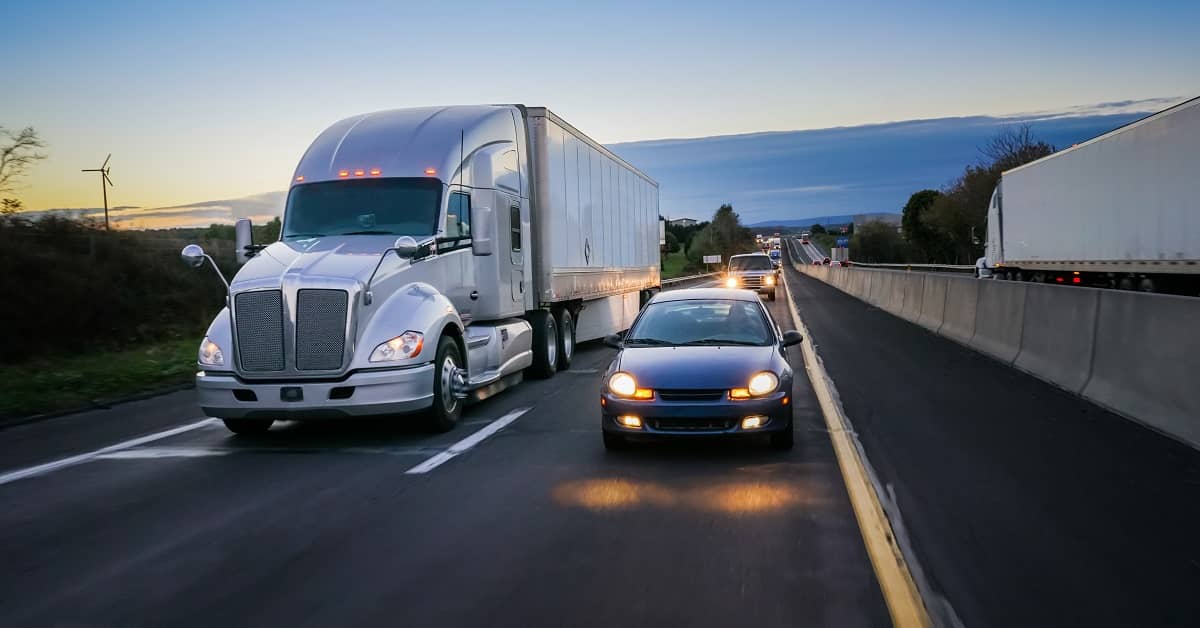Driving on the highway next to huge semi-trucks and trailers is a daily reality for many drivers, but these huge vehicles can be intimidating. While they’re an essential part of our economy, they present unique challenges for passenger vehicle drivers due to their size, weight, and limited maneuverability.

According to the National Safety Council, crashes involving large trucks claimed 5,472 lives in 2023, which is an increase of 40% in the last 10 years. Also in 2023, there were 114,552 large trucks involved in injury accidents. Knowing how to drive safely around these giant trucks is essential for everyone’s safety.
In this article, we’ll explore some practical tips for sharing the road safely with big rigs.
1. Stay out of blind spots
Every large truck has a significant blind spot where cars are invisible to the truck driver. These spots, also called “No Zones,” are located directly in front, behind, and on each side of the truck. As a rule, if you can’t see the truck driver’s face in their side mirror, assume they can’t see you.
Avoid lingering in blind spots to reduce the risk of an accident. Large truck accidents can cause serious injuries and fatalities. Many truck accidents occur when the driver can’t see the car. However, sometimes it’s not the car’s fault. It’s not unheard of for truck drivers to cause injury accidents while distracted, speeding, or driving under the influence.
When you approach a large tractor trailer or semi on the highway, don’t assume the driver is fully alert and actively looking for cars. Always plan to move around them as quickly and as safely as possible, rather than staying near them. Even if you drive in the next lane over, you will eventually end up in their blind spot, and you’ll be invisible when they need to change lanes.
2. Maintain a safe following distance
Large trucks need more time to stop because of their size and weight. Never tailgate a semi-truck – you’ll be in their blind spot and you won’t have as much time to react if the truck suddenly brakes. The Federal Motor Carrier Safety Administration (FMCSA) recommends staying back by one second for every 10 feet of vehicle length when driving under 40 miles per hour. On the highway, you’ll want to keep at least 7 truck lengths (around 500 feet) between you and the truck ahead of you, if not more.
3. Pass safely and quickly
It’s frustrating getting stuck behind a truck you can’t see around, but don’t let your emotions impact your driving skills. To overtake a big rig, do it fast, but be safe. Always pass on the left side where the driver has better visibility. After passing the truck, don’t cut back over until you can see the entire front end of the truck in your rear view mirror. This will ensure the driver will see you before you move into the lane.
4. Avoid cutting off large trucks
If you like to zip in and out of lanes on the highway, take a different approach around large trucks. Cutting off a semi-truck is extremely dangerous. They can’t stop quickly, and if you suddenly appear in their lane, they might hit you.
5. Be cautious with wide turns
Large trucks make wide right turns, and that often requires swinging way out to the left. Because of the way they have to maneuver the truck, it often looks like they’re driving straight ahead at first or turning left when they’re actually making a right turn. If you try to pass on either side, you’ll end up in the driver’s blind spot. Truck drivers can’t see cars trying to squeeze through to get around them, and they will most likely hit you. Anytime you see a truck’s turn signal on, or if it looks like they’re about to turn, stay put until it’s safe to continue driving.
6. Use signals early
The earlier you use your turn signals around a big truck, the better. Give them time to see you and note your intention to change lanes and turns as early as possible. They aren’t going to be staring at your car the whole time. Sudden moves can catch truck drivers off guard and cause an accident.
Safety on the road is a shared responsibility
Driving safely around semi-trucks and trailers requires effort, patience, and respect for the challenges these vehicles present. By following the tips outlined in this article, you’ll contribute to safer conditions on the road for everyone.